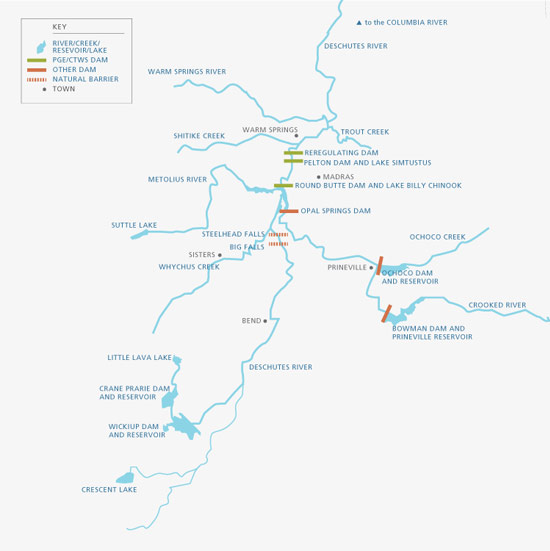
Our Story
Reconnecting the Deschutes River
For more than four decades, Portland General Electric and the Confederated Tribes of the Warm Springs Reservation of Oregon have co-managed the Pelton Round Butte project in Central Oregon, providing enough emissions-free hydropower to power more than 150,000 homes.
The historic challenge and collaborative solution
The Pelton Round Butte hydroelectric project was completed in 1964 and includes three dams situated along a 20-mile stretch in the Deschutes River Canyon.

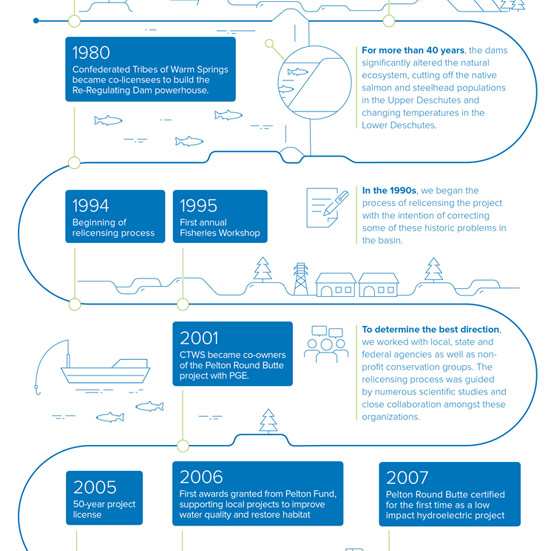
Science-based decision making
The project continues to be managed collaboratively by PGE, the Tribes and an active group of regional partners who make up the Fish Committee.
We continuously collect data and keep up with the latest science in order to review our successes and setbacks. All of this helps ensure that we are on the path to restoring a healthy Deschutes basin – a goal and long-term vision we share with our partners.
To help us move forward in the reintroduction process, the Fish Committee developed a roadmap of current and future strategies.
Our partners
Confederated Tribes of the Warm Springs Reservation of Oregon
The Tribes have partnered with PGE on the Pelton Round Butte project since 1980. Warm Springs Power and Water Enterprises manages the Tribes’ participation in the project.
Two independent Tribal agencies regulate our activities (in addition to Oregon State agency requirements), reflecting the Tribes’ regulatory jurisdiction:
Confederated Tribes of the Warm Springs Reservation of Oregon’s Branch of Natural Resources
Water Control Board: Monitors water to protect human health and safety and maintain a healthy ecosystem both on land and in the water. They regulate water quality along with the Oregon Department of Environmental Quality.
Pelton Round Butte Fish Committee members
PGE and the Tribes manage the project collaboratively with an active committee of local, state, federal and non-governmental organizations. The Fish Committee includes representatives from the following organizations:
Confederated Tribes of the Warm Springs Reservation of Oregon’s Branch of Natural Resources
Confederated Tribes of the Warm Springs Reservation of Oregon’s Water Control Board
Collaborative partners
We also have strong relationships with a number of other groups in the Deschutes River Basin. We work together on projects that improve fish passage, habitat and conservation.
Bonneville Power Administration
Crook County Soil and Water Conservation District
Crooked River Watershed Council
Deschutes Land Trust
Deschutes River Conservancy
Jefferson County Soil and Water Conservation District
North Unit Irrigation District
Ochoco Irrigation District
Oregon Watershed Enhancement Board
The Trust for Public Land
Three Sisters Irrigation District
Upper Deschutes Watershed Council

“When we started this journey of reintroduction, we knew there were going to be complex challenges. Having all stakeholders at the table assisting and understanding the challenges we encounter avoids any misunderstanding on the route we are taking to address them. Without collaboration we would be challenged to advance in an adaptive manner.”
– Jim Manion, Warm Springs Power & Water Enterprises – General Manager

A journey toward fish reintroduction
The Deschutes River Basin is known for its world-class fisheries, cherished by anglers, Tribal members and environmentalists alike. Many of the salmon and steelhead species native to the Deschutes are anadromous – migrating downstream to the ocean and back to freshwater during their lifetime. This journey is integral for fish survival and the health of the entire Deschutes ecosystem, bringing marine nutrients back to the upper tributaries and continuing the cycle for future generations. Daily fish counts and yearly run totals are available on the Fish Counts page.

An innovative solution for decades-old problems
Dam construction in the 1960s caused two serious problems: fish were unable to complete their migration and water temperatures were artificially disrupted. The Round Butte Hatchery was built to help make up for the loss of fish in the lower river, but wild fish were no longer able to make it upstream of the dams to spawn. This interruption was harmful to the river’s natural ecosystem as well as the Tribes’ heritage and culture.
Typically, licenses for hydro facilities last 30 to 50 years, and it was time for us to renew our license in 2005. To meet modern expectations for a healthy ecosystem, we researched, proposed and constructed an innovative solution: The Selective Water Withdrawal tower.

Learn more about how the SWW affects fish passage, water temperature, and power generation in the Deschutes.
Early successes in a long-term effort
Thanks to the SWW, fish are now completing their migration for the first time in nearly 50 years, swimming more than 200 miles to complete their natural lifecycle upstream of the dams.
Adult fish
Adult Chinook, sockeye and steelhead now have access to 250 miles of their historic habitat which were blocked for nearly 50 years.
We have located spawning fish near Bowman Dam on the Crooked River, in Whychus Creek at Camp Polk and upstream of Camp Sherman on the Metolius.
In 2016, over 500 adult sockeye returned to the basin after migrating through the SWW as juveniles.
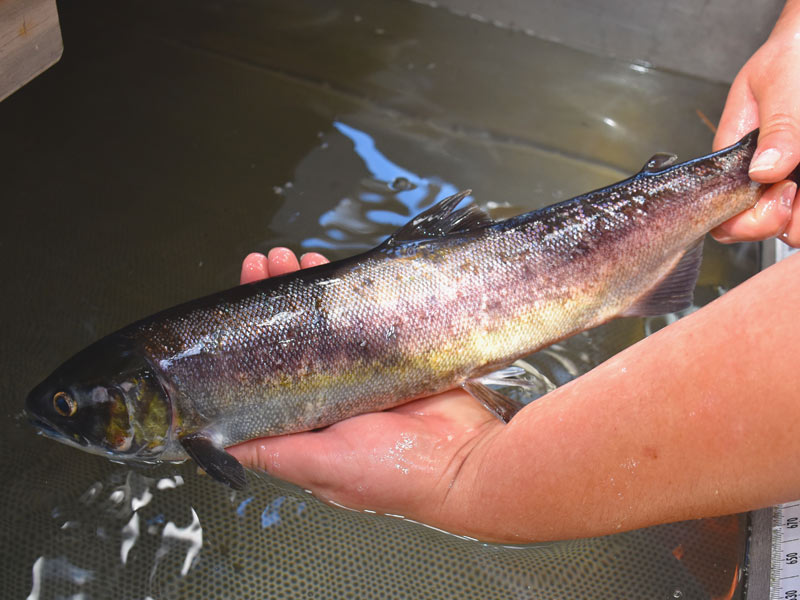
Juvenile Fish
Each year we collect between 45,000 and 450,000 smolts (juvenile fish) at the SWW.
Since the SWW went into operation, more than 1.5 million juvenile fish have been passed downstream.
In 2020, we partnered with the Oregon Department of Fish & Wildlife and Deschutes Land Trust to acclimate 85% of smolts prior to release. This likely contributed to our highest-ever collection of steelhead at the SWW.

Ongoing research
We’re proud of our achievements and optimistic about the future, always striving for a deeper understanding of the river and improved fish passage results. Subscribe to our newsletter for updates.



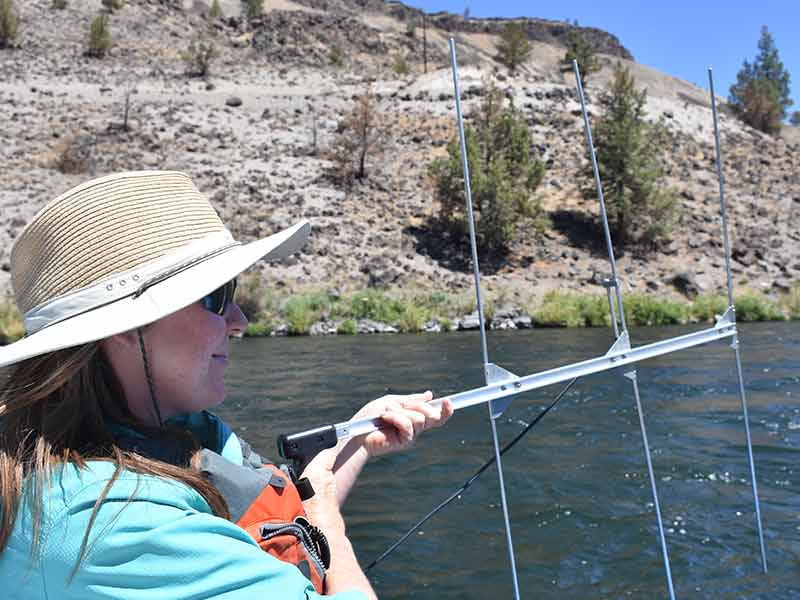




1 / 4
PGE biologists perform annual electrofishing surveys each fall, using specialized equipment to capture fish and generate population estimates.
Some fish are given radio tags so we can track their movements throughout the Deschutes basin. We follow their movements by foot, boat, and even helicopter.
We collaborate with ODFW and the Confederated Tribes of Warm Springs to collect kokanee in these seine nets. Fish are tagged, released, then spotted again a few months later to help us generate population estimates.
Our terrestrial biologists conduct bird surveys in the project reservoirs each winter, counting and identifying dozens of waterfowl, raptor and wading bird species.
Examples of adaptive management in action
As we continuously gather data, review the latest science and consult with the Fish Committee, we make thoughtful adjustments to our strategy.
Nighttime generation: Data suggested that juvenile fish travel at night, so in 2017, we began generating power in the evenings during peak migration season. This attracts more salmon and steelhead to the SWW, allowing them to migrate. Our collection efficiency in 2017 and 2019 were the highest on record – a direct result of nighttime generation.
Night releases: In 2017 we started releasing juvenile fish into the lower river at night to reduce the likelihood of predation by birds or other animals.
Smolt stocking: In 2019, we began shifting from fry stocking to a smolt-stocking program in response to data showing that smolts return at a higher rate and compete less with native redband trout.
Smolt acclimation: The Oregon Department of Fish and Wildlife, in partnership with PGE and the Tribes, has expanded the practice of smolt acclimation. Ocean-going steelhead are held in place for 10-30 days prior to release. Acclimation in 2018, 2019 and 2020 greatly improved our collection of juveniles at the SWW.
We are confident that we’re making progress toward fish recovery, and we continue to aim toward our principal long-term goal: sustainable, harvestable fish populations in the Upper and Lower Deschutes. The research we rely on to make informed, science-based decisions can be accessed on our Studies & Resources page.

Managing water in a complex ecosystem
PGE and the Tribes are dedicated to both improving water quality and enabling effective fish passage. Advancing these two objectives is quite challenging, and there is no “silver bullet” solution.
Restoring a more natural temperature pattern
Before the Selective Water Withdrawal was constructed, juvenile fish development was delayed due to unnaturally cold water released from the dam. These fish were smaller in size when migrating to the ocean, lowering their odds of survival.
The SWW enables us to correct this issue, mixing surface and bottom water to create a blend that more closely matches what the river would be like without the dam’s presence. To determine the appropriate water blend throughout the year, we compare discharge temperatures to a model of how the river would warm without the dams, and aim to match this calculated temperature.

Our dedicated team of researchers and biologists monitor water quality closely and communicate the results with our regulators.
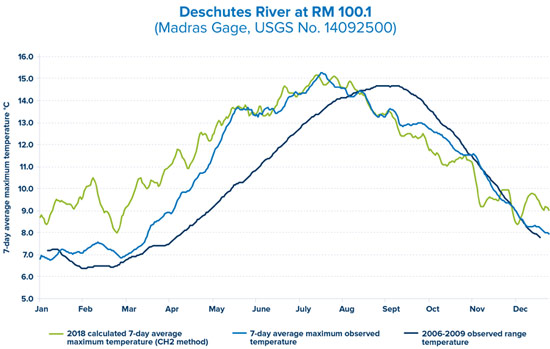
The SWW has helped restore a more natural temperature pattern, with warmer water released in the spring and summer and cooler water released in the fall and winter.
Water Quality Study
In February 2015, we kicked off an extensive multi-year water quality study to learn more about the Lower Deschutes River, the reservoirs and the major tributaries – the Metolius, Upper Deschutes and Crooked Rivers. By utilizing extensive data and sophisticated models, this study allows us, for the first time, to gain a more complete understanding of the complex relationships that determine conditions throughout the Deschutes River system.
In this study, as in all our research, we followed scientific procedures for data collection and publication so that the information we release is thorough and accurate. Read more about Deschutes water quality.

Investing in the Deschutes Basin
PGE and the Tribes established the Pelton Round Butte Fund to improve water quality and enhance habitat for fish throughout the entire Deschutes basin. Through this fund, we support local watershed and conservation groups with efforts above and below the Project.

Before and after Crook County Soil and Water Conservation District’s habitat recovery project at Hidden Falls, supported through by the Pelton Round Butte Fund. The project improved fish habitat by providing shade and restoring riparian vegetation.
We’ve supported 57 projects to date, and invested $26.5 million in efforts to remove fish passage barriers, stabilize stream banks, restore channels, and conserve water.
In 2020, we also launched the Lamprey Fund to support research and habitat improvement for these unique, eel-like fish.
Visit our Pelton Round Butte Fund or Lamprey Fund page for more information or to apply for funding.

“We’re thinking about the entire basin from the headwaters down, and what’s happening in all of those areas. Everything is connected.”
– Bobby Brunoe, Confederated Tribes of Warm Spring, Natural Resources – General Manager

Protecting wildlife, restoring habitat
A robust population of bald eagles, golden eagles, ospreys and prairie falcons live near the Pelton Round Butte Project in addition to a wide variety of other bird species. We perform extensive avian surveys and monitor raptors to learn more about their behavior, populations and range within the Deschutes basin.
Supporting Biodiversity





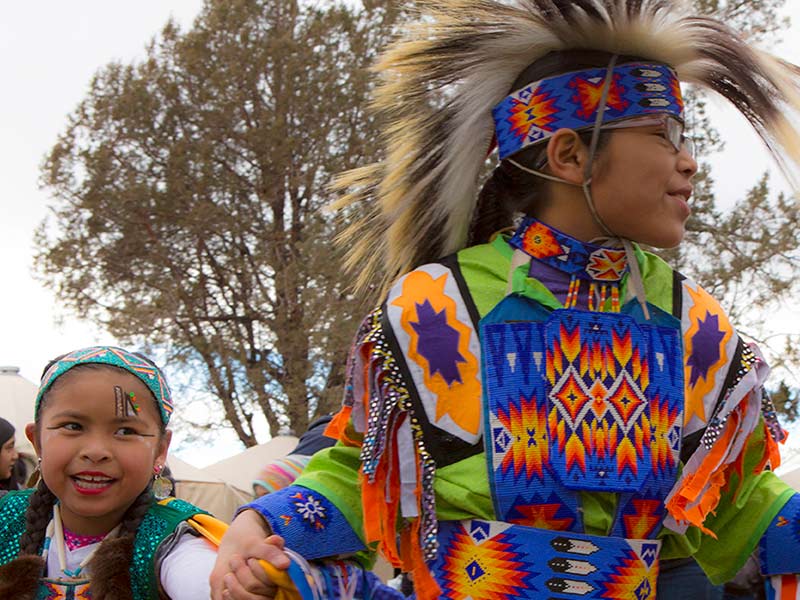
1 / 3
We also plant shoreline vegetation to improve riparian habitat for aquatic and terrestrial species.
The Metolius Mule Deer Winter Range is 160,000 acres of land situated between the Deschutes and Metolius arms of Lake Billy Chinook. This area provides critical winter habitat for mule deer, elk, bats and other wildlife. We coordinate with the Bureau of Land Management, the United States Forest Service, and Oregon Department of Fish and Wildlife to manage and monitor the land. By aligning our work, we maximize efforts and create larger blocks of wildlife habitat.
Each year, we’re proud to participate alongside our partners in events like Eagle Watch, encouraging members of the public to join us in celebrating the biodiversity of Central Oregon.
Habitat restoration
Learn more about some of the other work we do within our project areas to improve habitat for fish and wildlife:
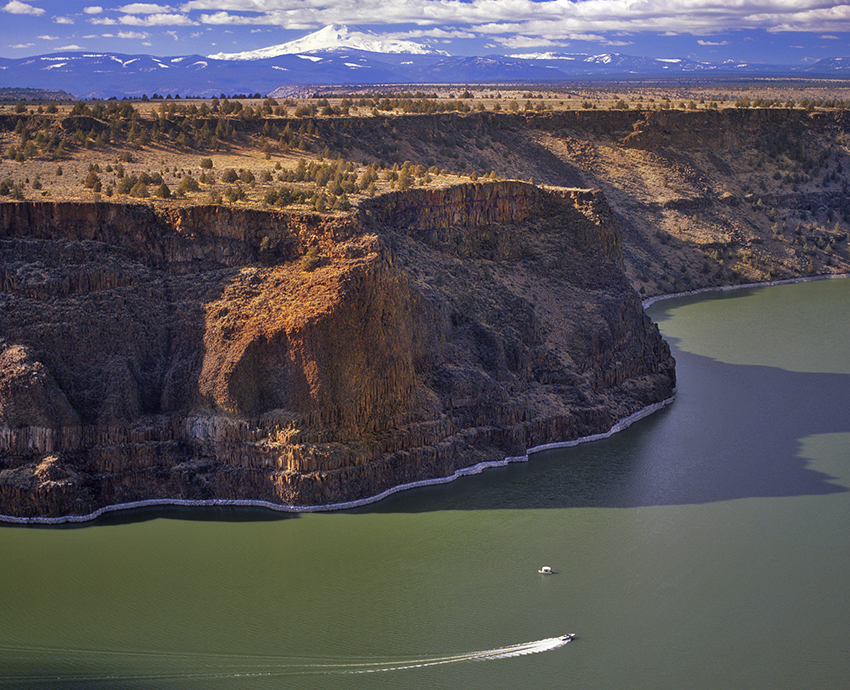
Recreation on the reservoirs
Lake Billy Chinook and Lake Simtustus, the reservoirs created by Round Butte and Pelton dams, are two of the most cherished recreation areas in Oregon and the Pacific Northwest, offering excellent opportunities for fishing, boating, paddling and wildlife viewing.
Camping
PGE provides camping opportunities at Pelton Park on Lake Simtustus, and Monty and Perry South campgrounds on the Metolius arm of Lake Billy Chinook.
The Cove Palisades State Park is another great option for those wanting to sleep under the stars after a full day of family fun on Lake Billy Chinook.

Day use
Come see what the Deschutes basin is all about by visiting one of our day-use areas. Don’t forget your binoculars!
For more information, check out these resources:

“Reintroducing salmon and steelhead into their historic habitats is an amazing opportunity and responsibility. I feel very fortunate to take part in this important effort, and to live, work and play in the Deschutes basin every day.”
– Megan Hill, Portland General Electric, Manager East Side Biological Services

Deschutes River info
Visit this page to access fish counts, fact sheets and recent studies, information on water quality, upcoming events and more.

Fish Committee Roadmap
Learn more about the Pelton Round Butte Fish Committee ’s strategies for reintroducing salmon and steelhead to the Deschutes.